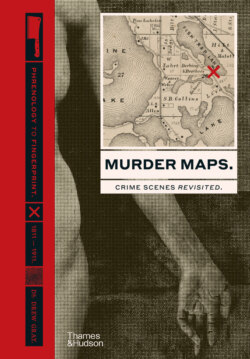Читать книгу Murder Maps - Drew Gray - Страница 48
На сайте Литреса книга снята с продажи.
Оглавление2
3QUEBEC. the city from which chief inspector walter dew contacted the canadian authorities.
4
47
ENGLAND — LONDON.
A discovery in the cellar of Crippen’s home changed everything. A police search unearthed what appeared to be human remains, wrapped in cloth, under the flagstones. ‘We found only masses of human flesh,’ Dew wrote in his memoirs. ‘The head was missing. No bones were ever discovered. Identification seemed impossible.’ An unrivalled team now investigated the find; the pathologist, Augustus Joseph Pepper (1849–1935), and Bernard Spilsbury (1877–1947), his junior, were assisted by two toxicologists: William Willcox (1870–1941) and Arthur P. Luff (1855–1938). A scar on the abdomen was assumed to be evidence of a miscarriage Cora had suffered and a pyjama top found in the house matched the cloth found wrapped around the body in the cellar grave.
The forensics experts were sure that this was Cora’s mutilated body; they now had to determine the cause of death. A chemical test for alkaloids revealed the presence of the poison hyoscine, which was far from a common means of killing. Crippen was an expert in drugs, having trained in medicine in the United States (where he was born) and in London. He sold remedies by post, and a pharmacist testified that Crippen had purchased 5 grams (¹⁄5 oz) of hyoscine hydrobromide on 19 January 1910. The evidence was stacking up, but the police still did not have a suspect in custody because Crippen had vanished.
Then Dew got the breakthrough he needed. The captain of the Montrose, a passenger ship bound for Montreal, Canada, who had seen the press reports of Crippen’s flight sent a ‘marconigram’ (radio telegram) to his employers. The message, passed on to Dew, relayed that the captain believed he had the fugitives on board under false names, with Ethel (disguised as a boy) travelling as Crippen’s son. This was to result in Crippen becoming the first criminal to be caught with the aid of wireless telegraphy. Dew boarded a faster vessel – the Laurentic – and arrived in Quebec, Canada, on 30 July, at Farther Point, where the Montrose docked a day later. Dew went aboard disguised as a ship’s pilot and arrested Crippen, who made no attempt to escape. ‘I won’t [jump],’ he told Dew, ‘I am more than satisfied because the anxiety has been too awful.’
Crippen’s trial began on 18 October amid huge public interest. It lasted five days and the jury took just twenty-seven minutes to convict him. Ethel was acquitted of being an accessory, and sold her story to a newspaper. After an appeal failed, John Ellis (1874–1932) hanged Crippen at Pentonville Prison on 23 November 1910. 39 Hilldrop Crescent was bombed during the Second World War. Cora’s head and limbs have never been found, leaving the remote possibility that the remains belonged to someone else. Crippen killed for love and he maintained Ethel’s innocence to his last breath. •
ST LAWRENCE RIVER. the location of the ss montrose when
chief inspector walter dew arrested hawley crippen.
F
G
HI
ethel le neve arriving at holloway prison following her arrest
as an accomplice.
crowds outside the bow street magistrates’ court
during the trial.
hawley crippen and ethel le neve in the
dock at their trial.
newspapers publicizing the
details of the case.
